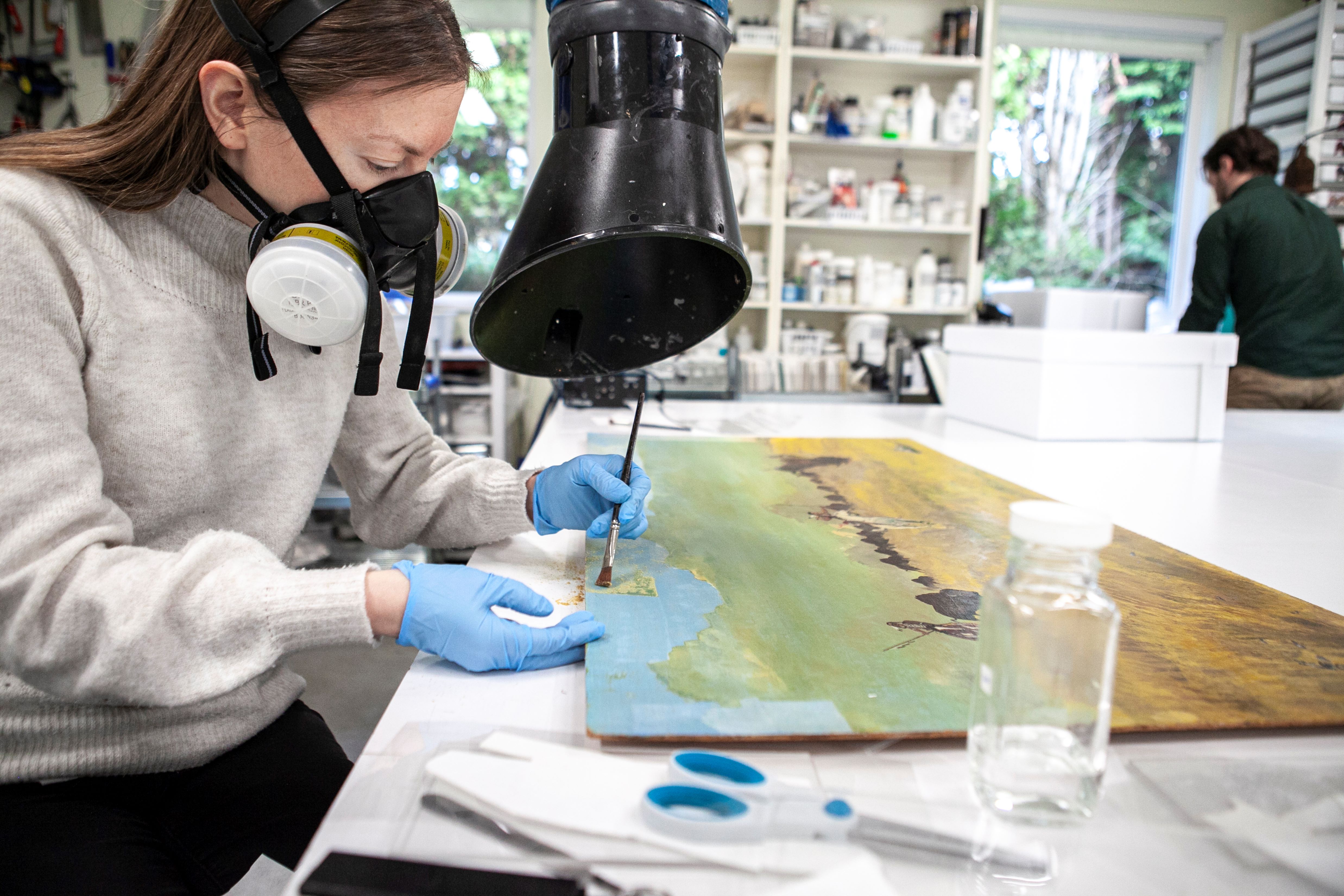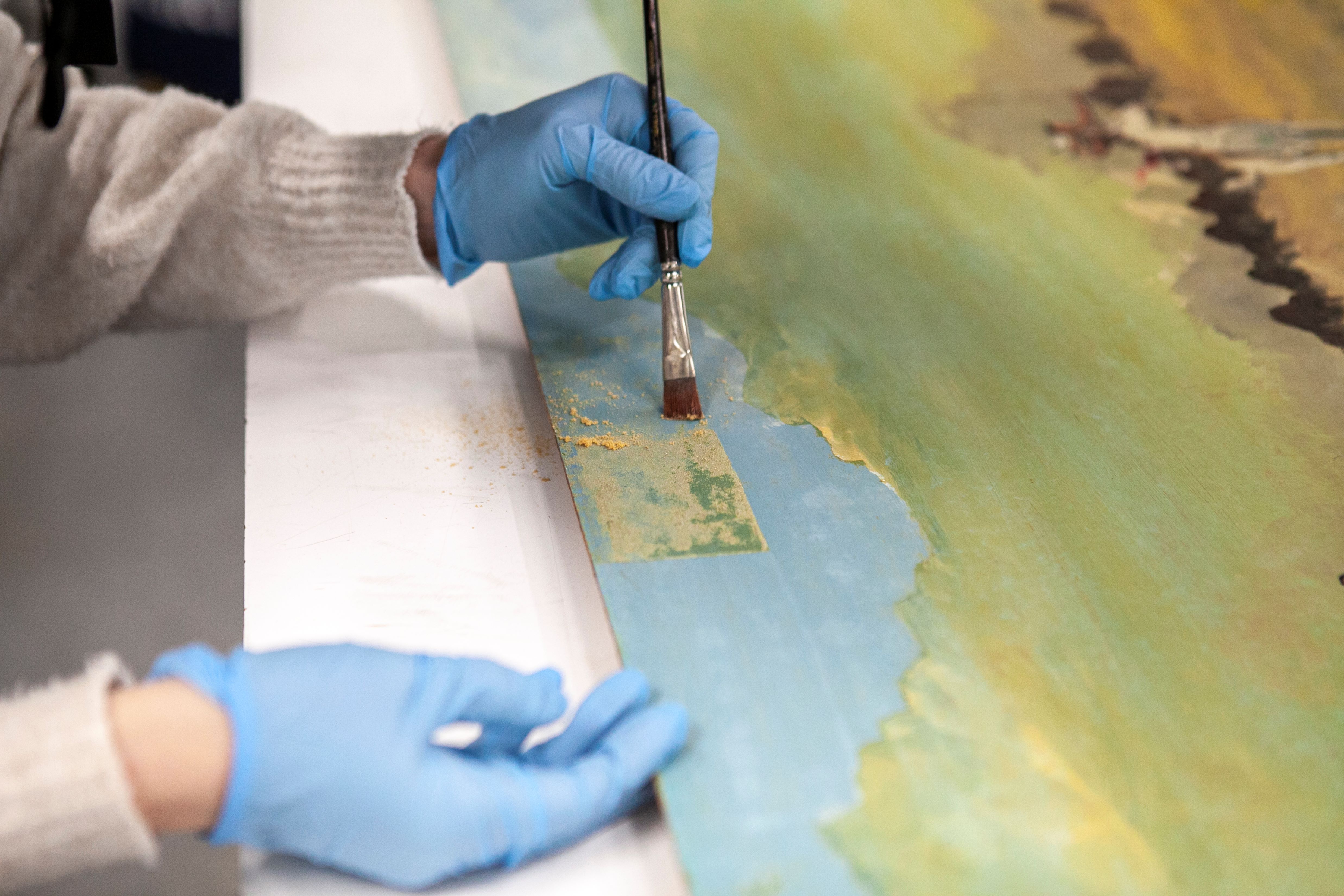SK Arts acquired The Buffalo Hunt by Henry Beaudry through a donation by Sandy Macknak in 2022. One of the lesser-known contemporary artists of his time, SK Arts is pleased to have Beaudry included in the expansion of the collection to include more Indigenous artists.
The painting was commissioned as a Christmas gift from John Warner to Macknak and her late husband, Dennis. Sandy fondly recalls their visit with Beaudry and his wife. Both women had been expectant mothers talking about their experiences when the work was commissioned. Beaudry told Sandy that the painting reflected a vision he had about hunting, inspired by his ancestry and that he (Beaudry) knew just what he wanted to paint when he set to work on it.
The Beaudry donation was the largest of three the donor owned and came to SK Arts as Macknak was downsizing. She thought SK Arts to be the perfect home to allow the painting to be seen and shared with an audience.
“It is such a great representation of what you imagine such a hunt to have looked like. I hope it can be shared and appreciated as it should be,” shared Macknak. “I am just grateful to SK Arts for accepting the piece so that it gets the attention it deserves.”
The Restoration Process
The 1971 artwork had yellowed discolouration due to a thick, insoluble layer of polyurethane varnish, dirt and grime. SK Arts connected with an art conservator company, which removed the varnish through a complex and time-consuming process. The work went straight to the conservators from the donor.
Sarah Spafford Ricci, co-founder and principal conservator of Fine Art at Fraser Spafford Ricci Art & Archival Conservation and Christine Foster (MA), senior paintings conservator, worked extensively on the project. Sarah Spafford-Ricci and Foster shared that the restoration was a challenging process, requiring ingenuity. Powered by decades of experience conserving and restoring art, the team is delighted at the project's outcome, sharing their honour in restoring the work to the artist's 'original intent'.
"The varnish is practically insoluble and technically not removable from an artist's oil painting since the varnish layer is less soluble than the art paint," said Sarah Spafford-Ricci. "We have many years of experience tackling varnish removals from paintings, sometimes in very innovative ways. We used a strong solvent through a microchamber material to desiccate the varnish, then removed it in small sections."
Testing revealed the painting had a thick layer of polyurethane varnish typically used to conserve wood. While this type of varnish was not the best material for artwork, it was a cheap and accessible alternative. Not intended for artwork or removal, the varnish's presence atop the more sensitive artwork painting layer made for highly specialized work.


Christine Foster brushing away desiccated varnish from the Beaudry painting. Photo credit: Photo credit: Fraser Spafford Ricci Art & Archival Conservation Inc.
Foster, a specialist in early modern North American paintings across the entire treatment spectrum and diagnostics, mentioned the restoration project to be challenging, requiring ingenuity, expertise and delicacy in its application.
“The removal was so difficult because it required a unique method to remove the uneven coating of polyurethane varnish — a strong varnish meant for wood furniture,” said Foster. “On a fine art oil painting, it is technically not removable because it requires such a strong solvent that this solvent also removes the paint.”
Removing any varnish from paintings is a delicate process, requiring expertise and precision. Artist varnishes are specially formulated to be more soluble than the paint when properly used and are removable with the proper solvent and care. As experienced professionals, the conservators carefully test different solvent combinations to find the best mixture for removing old, degraded varnish from paintings. A solvent is applied carefully to cotton swabs to dissolve the varnish without damaging the underlying paint layers.
“For normal varnish removals where we remove artist varnish, we test for the use of various solvent combinations to find a good mixture that will remove an aged, deteriorated varnish from a painting, and we use this solvent on cotton swabs,” Foster continued. “With this painting, after several hours of testing, we realized that a powerful solvent was required, so it could not be cleaned in this manner. We instead introduced this solvent by applying it through a semipermeable membrane called Evalon, and we covered this with Mylar and lightly weighted it to form a good contact for an exact time.”
As a result of the solvent vapours, the varnish layer was dehydrated and transformed from a film into a powder, making it easy to brush off. However, the artist paint in the foreground was more delicate and required a different approach. The conservators could only partially dehydrate the varnish and had to remove it using a milder solvent applied using swabs.
The method was repeated strategically in very small sections following the shapes of the painting to control the vapour’s effect and the location of the shape boundaries. This time-consuming but necessary process which was highly successful. The painting required very little in-painting (touch-ups) afterward. Upon completion, a carefully chosen appropriate varnish, not prone to discolouration for over 100 years, was applied to the painting.
The Buffalo Hunt, Henry Beaudry, 1971 before and after restoration. Photo credit: Fraser Spafford Ricci Art & Archival Conservation Inc.
About the Artist
Henry Beaudry (d. 2016) was a war veteran and native artist born on the Poundmaker's Reserve in 1921. He was the grandson of the prominent Plains Cree Chief Poundmaker. Beaudry joined the Canadian Armed Forces at 19 years old, where he fought in World War II and became a Prisoner of War (POW) after his capture in Italy in 1944. Beaudry escaped to Holland before the end of the war and eventually made his way back to Canada where he settled in Mosquito First Nation.
Beaudry took up drawing on paper in his spare time. His son took his drawings to school — trading and selling them. He eventually moved on to painting and became a distinguished artist. His work — focused heavily on stories of his time at war, Native life realism and elders — was exhibited throughout the 1970s-1990s and is represented in private and public collections across Canada.
The Buffalo Hunt has now become part of SK Arts’ Permanent Collection and is available for loan and rental.

